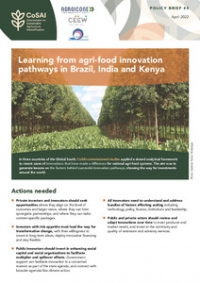The International Water Management Institute-Tata Policy Research Program Annual Partners’ Meeting (ITP-APM 2012) got down to business last week in Anand, Gujarat. Researchers and partners discussed some of India’s most pressing water management problems.
A key focus was groundwater governance. Over the past 50 years or so, the world has seen an exponential increase in groundwater use, driven mainly by growth in population and agriculture. Groundwater management has been hit by its own distinct problems trying to keep up with the accelerated growth. In South and Southeast Asia, groundwater is the main source of water for over 95% of the rural population1. For them it is an ‘invisible’ resource: impossible to see and assess for sustainable use.
A drain on resources
In the Global South, effective governance and management of groundwater extraction and use is urgently required. And it’s messy at both ends. At the top, multiple sometimes overlapping bureaucracies govern resource provision while at the bottom, stiff farmer resistance hinders usage restriction.
40% of the world’s food is produced by irrigated agriculture which accounts for 20% of farmed land2. Responsible human development without depleting and polluting precious groundwater resources over the next 50 years will be key to finding balance in the water-energy-food nexus.
But despite improving the lives of millions of poverty-stricken rural, families, the low returns in wealth creation in groundwater irrigation for poor farmers are effectively keeping away most science, technology and management initiatives1.
Water User Associations
In both India and China groundwater development has been traditionally initiated by small scale farmers and village Water User Associations (WUAs) are widespread. But the similarities seem to end there. In China they have shown some success in curbing excessive groundwater use. In India, weak resource management capacities and minimal governing authorities battle a logistical nightmare of vast numbers of widely scattered rural users, who see any proposed curbs as a huge threat to their livelihoods and are ready to organise social unrest at any hint of restriction.
The Minqin Experience
An ITP case study from Minqin County, China highlights differences in how the two countries are tackling management at the community level. Here, uncontrolled tubewell drilling since the 1970s caused serious groundwater depletion leading to the desertification of an oasis bordering the Gobi desert. Since 2007, state intervention has restored the oasis by greatly reducing groundwater use in agriculture. The study shows however that WUAs that were formed at the time were an essential part of the success story. A combination of self-regulation, local management and state control was necessary to effect results. The role of the pre-existing collective groundwater institutions changed from controlling excessive water use to conserving water.
So why can’t it be replicated in India? Tushaar Shah explains that the local context becomes all-important and that in China, state control is more rigid than in India, where politics makes regulation more elastic. In India, demand restriction approaches remain unpopular even as concerns grow about resource protection and sustainability. Risking revolt from a vast voter base is unappealing to government.
India’s power subsidies for farmers result in 30-40% of power and groundwater going to waste. This unique system of subsidies for farmers creates an additional barrier for implementing solutions that may work in other areas like China.
Gender agenda
An often overlooked, yet important factor of underperforming WUAs throughout much of South Asia is the under-representation of women and other minorities. In India, many women are not given a voice at WUAs where their active participation is prevented by socially constructed barriers 3. One study on Tamil Nadu presented at the IWMI-TATA conference found that only 12% of WUA members are women in the 24 WUAs studied. Of the female WUA members, 72% do not actively participate.
Because women don’t own land, they are often left out of WUAs. Gender discrimination is widespread throughout a patriarchal culture and system of governance, involuntary or otherwise4. The decision making process is dominated by social inequities. Landless men are also left out of WUAs along with other marginalized groups such as Dalits (Untouchables). Participants at the “Gender Issues in Agricultural Water Management” session lamented that while equity issues are addressed in the domestic sector, they are often overlooked in the productive sector.
In Andhra Pradesh, 300,000 acres of land were registered in the name of women, one participant commented. However, is simply registering land in the name of women enough to ensure their participation in WUAs? We are sometimes misguided by counting men and women instead of analysing how such measures affect participation of marginalized groups. Even though legal provision exists for equitable representation, traditional inequalities endure5.
Intelligent tailoring of strategies that include ground realities and all stakeholders are required for groundwater governance and participatory governance at community level to be effective. Shah emphasizes that learning from others’ experiences elsewhere are important but stresses that it is the home grown, context-based approaches which balance resource protection with supporting poor people that will succeed.
Sources:
1 Groundwater Topic Page, IWMI
2World Water Assessment Programme, UNESCO
3 Fencing Women in Water User Associations: An Appraisal of Gender Strategy for Participatory Irrigation Management in Tamil Nadu. K. Gulam Dasthagir. IWMI
4 United Nations World Water Development Report 4 (Vol1.) 2012
5Redefining Irrigation as if Gender Mattered. Seema Kulkarni. IWMI















